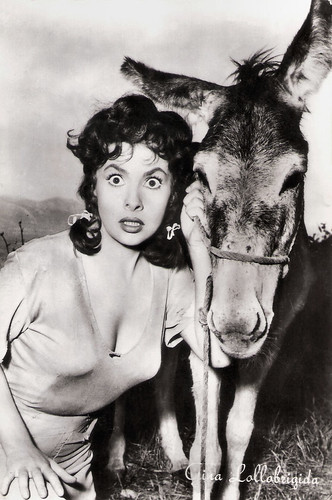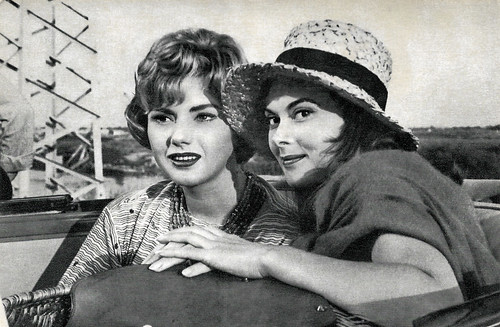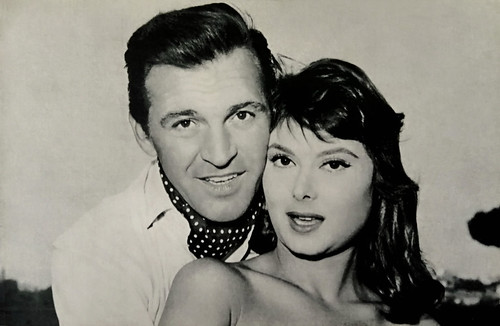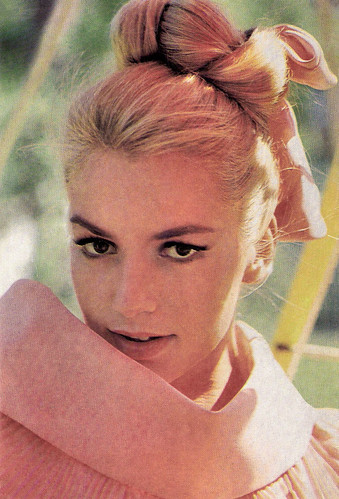
French postcard by Entr'acte, no. 005/6. Photo: Collection: B. Courtel / D. R. Gina Lollobrigida and Luigi Comencini (in the middle) on the set of Pane, amore e fantasia / Bread, Love and Dreams (Luigi Comencini, 1953). Caption: A moment of concentration for Gina Lollobrigida: Luigi Comencini directs the star.

Small Italian collector card, no. 291. Photo: Ivo Meldones. Totò in L'imperatore di Capri / The Emperor of Capri (Luigi Comencini, 1949).

French postcard by E.D.U.G., no. 55. Gina Lollobrigida in Pane, amore e fantasia / Love, Bread and Fantasy (Luigi Comencini, 1953).

Small Czech collector card by Pressfoto, Praha (Prague), no. S 101/8. Claudia Cardinale and director Luigi Comencini, director of La ragazza di Bube / Bebo's Girl (1964), at Karlovy Vary International Film Festival.

Italian postcard. Stefano Colagrande in Incompreso / Misunderstood (Luigi Comencini, 1966). Caption: "Questo è il solo film che andro a vedere. James Bond" (This is the only movie I'll go to see. James Bond).
The most successful Italian film of the early 1950s
Luigi Comencini was born in 1916 in Salò, located on the shores of Lake Garda, Kingdom of Italy. He was the son of Cesare Comencini and Maria Magdalena Comencini, known as Mimì. He spent his childhood in Agen, in southern France, following his engineer father, where he began to take an interest in cinema. On his return to Italy, he studied architecture at the Milan Polytechnic. A passionate cinephile, in the late 1930s, he, together with Mario Ferrari, who died young in 1938, and the future director Alberto Lattuada, began collecting films and exchanging them with French enthusiasts like Henri Langlois. This was the core for the future Cineteca Italiana of Milan. As a member of the GUF (University Fascist Group), he took part in the Littoriali della cultura e dell'arte (Littoriali of Culture and Art), winning one edition.
He hated fascism, though, and after World War II, he began as a newspaper film critic for the socialist newspaper 'Avanti'. His career as a filmmaker began in 1946 with the release of Bambini in città / Children in the City (1947), a documentary about the harsh lives of children in Milan during those postwar months. Childhood and adolescence were themes that would accompany him throughout his career. This brought him to the attention of the biggest film company in Rome of the time, Lux, where he was hired by Carlo Ponti to direct what was intended as an Italian version of Hollywood's Boys Town (Norman Taurog, 1938), set in Naples. The result, the flop Proibito rubare / Stealing Forbidden (1948), obliged him to accept a commercial chore.
This became his first successful film, the comedy L'imperatore di Capri / The Emperor of Capri (1949), featuring Totò. His next films included the erotic melodrama Persiane chiuse / Behind Closed Shutters (1951) starring Massimo Girotti, Eleonora Rossi Drago and Giulietta Masina, the Swiss family drama Heidi / Heidi, Child of the Mountain (1952) starring Elsbeth Sigmund and Theo Lingen, and the comedy La valigia dei sogni / Suitcase of Dreams (1953) with Umberto Melnati and silent star Helena Makowska. He made La valigia dei sogni to provide financial support to the Cineteca. Several scenes and part of its voice-over were borrowed from the documentary Il museo dei sogni, which he had made several years earlier. His aim was to use a fictional narrative to raise public awareness and interest in the heritage of Italian silent cinema, which was gradually disappearing.
His comedy Pane, amore e fantasia / Bread Love and Dreams (1953) is a primary example of 'Neorealismo Rosa' (pink neorealism). The fortunate pairing of Vittorio De Sica as the philandering middle-aged carabinieri and the pin-up star Gina Lollobrigida as the peasant beauty was a winning formula. It became the most successful Italian film of the early 1950s, and was followed by the equally successful Pane, amore e gelosia / Bread, Love and Jealousy (1954) with the same stars.
Though he refused to make the third film in the series, he played safe by testing his newly won box office credibility with three more comedies in a row, including La Bella di Roma (1955), starring Alberto Sordi. Only then did he feel ready to make a film which he would always cite as one of his favourites, La Finestra sul Luna Park / Window on the Fairground (1956), about the relationship between father and son. It was a subject he felt deeply about, and it became a recurring theme in his work. However, the film was a flop, so he had to return to commercial work.

German collector card. Theo Lingen in Heidi (Luigi Comencini, 1952).

Italian postcard by Rotalfoto, no. 241. Maria Pia Casilio in La valigia dei sogni / The Suitcase of Dreams (Luigi Comencini, 1953).

Yugoslav postcard by NPO, no. G5. Photo: G.B. Poletto. Gina Lollobrigida and donkey in Pane, amore e fantasia / Bread, Love and Dreams (Luigi Comencini, 1953).

Dutch postcard by Uitg. Takken, Utrecht, no. 1748. Gina Lollobrigida in Pane, amore e fantasia / Bread, Love and Dreams (Luigi Comencini, 1953).

Italian postcard in the I Carabinieri nel Cinema series. Photo: Titanus. Photo: G.B. Poletto. Gina Lollobrigida and Vittorio De Sica in Pane, amore e gelosia / Bread, Love and Jealousy (Luigi Comencini, 1954).
One of the most famous examples of the Commedia all'italiana
In 1960, Luigi Comencini made his masterwork, the bitter comedy Tutti a casa / Everybody Go Home (1960), set during the Allied invasion of Italy in 1943. Featuring an international cast that includes Alberto Sordi, Martin Balsam, Eduardo De Filippo, and Serge Reggiani, the film is one of the most famous examples of the Commedia all'italiana. Sordi played a soldier in September of 1943, obliged to choose between carrying on the war with the fascists and Nazis or joining the resistance. The film won the Special Golden Prize at the 2nd Moscow International Film Festival.
In the 1960s, he continued to alternate hits with flops. Another masterpiece is the comedy-drama A cavallo della tigre / On the Tiger's Back (1961). Nino Manfredi stars as an inept thief who wants to escape prison and return to his family, but two of his prison mates (Mario Adorf and Gian Maria Volonté) also want out.
Comencini directed another famous war film, La ragazza di Bube / Bebo's Girl (1963), starring Claudia Cardinale and George Chakiris. It is set immediately after World War II, but this time devoted to the Italian partisans. The film was nominated for a Golden Bear Award at the 14th Berlin International Film Festival and won the Best Production Award at the David di Donatello Awards. Cardinale was awarded the Nastro d'Argento for Best Actress (Migliore Attrice Protagonista) for her role as Mara.
Comencini also directed the comedy Il compagno Don Camillo / Don Camillo in Moscow (1965) with Fernandel and Gino Cervi. It was the fifth film in the Don Camillo series.
This was followed by the beautiful melodrama Incompreso / Misunderstood (1966), based on an adaptation of a classic weepie of late nineteenth-century English literature by Florence Montgomery about a father's failure to understand his children's feelings. Comencini transforms this 'job-for-hire' into a subtle and highly personal film. The film, starring Anthony Quayle, earned Comencini his first David di Donatello award and a nomination for the Golden Palm at the Cannes Film Festival. It was more appreciated by audiences outside Italy than at home. Another film about a child followed, Infanzia, Vocazione e Prime Esperienze di Giacomo Casanova, Veneziano / Giacomo Casanova (1969).

German postcard by Ufa, Berlin-Tempelhof, no. FK. 4571. Photo: CCC / NF-Film / Arthur Grimm. Blandine Ebinger in ... Und das am Montagmorgen / And That on Monday Morning (Luigi Comencini, 1959).

Romanian postcard by Casa Filmului Acin, no. 13. Sylva Koscina and Dorian Gray in Le sorprese dell'amore / Surprise of Love (Luigi Comencini, 1959).

Romanian postcard by Casa Filmului Acin, no. 14. Franco Fabrizi and Dorian Gray in Le sorprese dell'amore / Surprise of Love (Luigi Comencini, 1959). Collection: Alina Deaconu.

Small Czech collector card by Pressfoto, Praha (Prague), 1965, no. S 101/7. The retail price was Kcs 0,50. Photo: Claudia Cardinale in La ragazza di Bube / Bebo's Girl (Luigi Comencini, 1964), the film which was presented at the Karlovy Vary International Film Festival 1964.

Romanian postcard by Casa Filmului Acin, no. 91. Catherine Spaak in 3 notti d'amore / Three Nights of Love (Renato Castellani, Luigi Comencini, Franco Rossi, 1964).
Another variation on the father-son theme
Luigi Comencini was the ideal director to handle the subject of children. Italy's public broadcaster, RAI, commissioned him to make a documentary series, Bambini e Noi / Children and Us (1970). He then had an outstanding success with another variation on the father-son theme, Le avventure di Pinocchio / The Adventures of Pinocchio (1972), starring Andrea Balestri as Pinocchio, Nino Manfredi as Geppetto and Gina Lollobrigida as The Fairy with Turquoise Hair. Based on Carlo Collodi's 1883 novel, the six-part Mini-series received a large critical success, and had an average of twenty-one and a half million viewers during its first airing.
In the same year, he directed the feature film Lo scopone scientifico / The Scientific Cardplayer (1972), a dark comedy about how money corrupts, with Alberto Sordi, Silvana Mangano and Bette Davis. Both Sordi and Mangano won the David di Donatello Award for their roles. His drama Delitto d'amore / Somewhere Beyond Love (1974), starring Giuliano Gemma and Stefania Sandrelli, was entered into the 1974 Cannes Film Festival. In 1975, he released the mystery La donna della domenica / Sunday Woman, featuring Marcello Mastroianni, Jacqueline Bisset and Jean-Louis Trintignant.
Comencini's subsequent works were characterised by the presence of famous Italian actors of the time: Ugo Tognazzi in the Giallo comedy Il gatto / The Cat (1977), or Nino Manfredi in his episode of Basta che non si sappia in giro. A box office hit was the satirical comedy-drama L'ingorgo - Una storia impossibile / Traffic Jam (1979). The film, based on the short story 'L'Autoroute du sud' (1966) by Julio Cortázar, was entered into the 1979 Cannes Film Festival. The comedy-drama Voltati Eugenio / Eugenio (1980) entered the 37th Venice International Film Festival and won the David di Donatello for Best Score.
His television series Cuore / Heart (1984), based on Edmondo de Amicis's children's classic, and La Storia / History (1986), based on Elsa Morante's best-selling novel and starring Claudia Cardinale in a Magnani-like role, were praised. The film Un ragazzo di Calabria / A Boy from Calabria entered the main competition at the 44th Venice Film Festival, in which it won the Pasinetti Award for Best Actor (to Gian Maria Volonté), but his other films in the 1980s were disappointing. Comencini's final film was Marcellino (1991), a rather pointless remake of the Spanish film Marcelino pan y vino / The Miracle of Marcelino (Ladislao Vajda, 1955).
For the last three decades of his life, he suffered from Parkinson's disease. Luigi Comencini died in Rome in 2007. He was 90. He and his wife, Giulia Grifio, had four daughters, including the directors Cristina and Francesca Comencini, costume designer, set designer and art director Paola Comencini and production manager Eleonora Comencini.

Italian postcard. Stefano Colagrande and Simone Giannozzi in foreground and Anthony Quayle in Incompreso / Misunderstood (Luigi Comencini, 1966). Caption: "Questo è il solo film che andro a vedere. James Bond" (This is the only movie I'll go to see. James Bond).

Italian postcard. Stefano Colagrande at right and Simone Giannozzi in the middle in Incompreso / Misunderstood (Luigi Comencini, 1966). Caption: "Questo è il solo film che andro a vedere. James Bond" (This is the only movie I'll go to see. James Bond).

Italian postcard by Edizioni Panini, Modena (EPM). Photo: Sampaolofilm / Cinepat. Gina Lollobrigida and Andrea Balestri in Le avventure di Pinocchio / The Adventures of Pinocchio (Luigi Comencini, 1972). Caption: The Fairy and the boy Pinocchio.

French poster postcard by Eds. F. Nugeron. Poster by Yves Prince for La Storia (Luigi Comencini, 1986), starring Claudia Cardinale.
Sources: John Francis Lane (The Guardian), Il Cinema Ritrovato, Wikipedia (Dutch, Italian and English), and IMDb. And thanks to Marlene Pilaete.
No comments:
Post a Comment